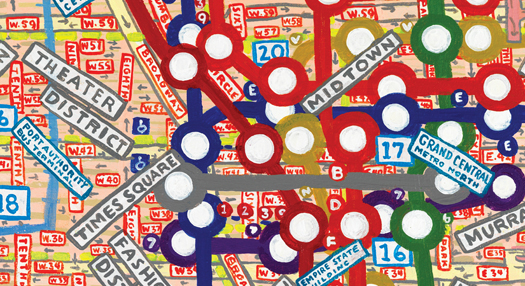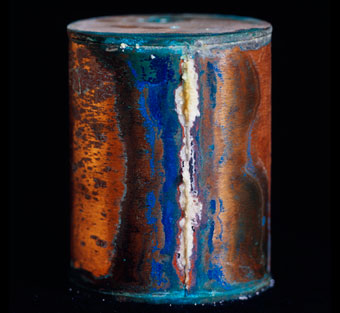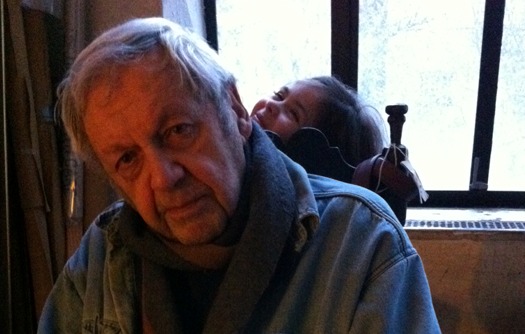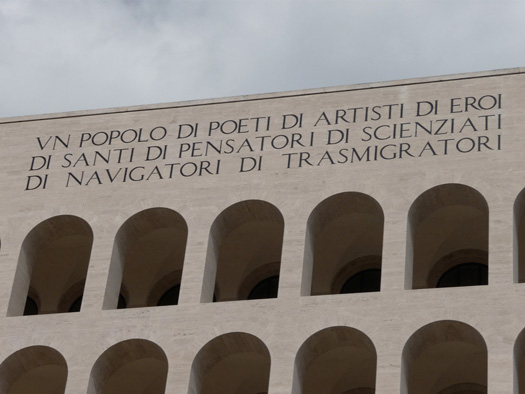
June 21, 2010
Fascist Seduction

EUR, also known as E42, is a vivid example of how something designed to signify one charged entity (the dominance of the Fascist party over the individual) can be transformed into another benign one (a residential and working environment), if only by circumstance (loosing the war). Or stated another way, just because the Fascists conceived, designed and partially built it (it was only completed after the war) doesn’t mean that over time it cannot be neutralized, or even redeemed. Yet, to be honest, I realize that the plan, buildings and sculptures are imposing in a manner that only an adulation-addicted dictator with a Caesar-complex could conjure. Therein lies the paradox. Knowing the motivation yet still “appreciating” the outcome suggests a deeper psychological complexity rooted in how effectively stirring or soothing the power and impact of propaganda is — EUR is a great example of this: beautiful propaganda-architecture.
Mussolini’s embrace of Italian Futurism (albeit briefly) suggested a more progressive outlook than the aesthetically reactionary German Führer, Herr Hitler; Duce’s architectural preferences were certainly less gothic and less medieval. While Mussolini extolled the style and trappings of ancient Rome (i.e. the Roman salute and the fascist emblem), he allowed for crosscurrents of Classicism and Modernism to run through Fascism, which contributed a bit of Mediterranean flair. To this day, the remnant of Fascist style continues to be subtly evident in Rome. (Having just spent a week there with students, as part of a design workshop, I watched how seduced some where by the Fascist facades and block letter inscriptions. Indeed, some drew inspiration for making original typefaces through their own interpretation of classic and fascistic lettering.)
What surprised me, however, was how totally taken I was by EUR’s centerpiece, Palazzo della Civiltà Italiana, with its precisely Roman-lettered inscription atop all four sides of the structure, a six-story white box evenly punctuated by eight arched openings across and six down (presumably symbolizing the name Benito (down) Mussolini (across). It is the image in so many di Chirico paintings of fascist town squares. While EUR is imposing both in its volume and mass, it is also curiously more manageable than Hitler’s un-built superannuated Germania in terms of the height and breadth of the structures. The Palazzo, which is also known as the “Colosseo Quadrato,” or Square Colosseum, because its arches echo the landmark Coliseum, is the tallest structure of the complex and sits impressively alone on a small hill, unencumbered by other structures, starkly graphic against the sky, surrounded by a base of white limestone stairs, grass and heroic marble sculptures. From a distance, on the way to the airport, it is the most impressive structure on the horizon.
The Palazzo is complimented by a number of other fascist buildings, including the Museum of Roman Civilzation, with its impressive colonnades, resembling centurions standing at rigid attention. Although the uninformed visitor might never know all these structures (most of it constructed on the original plan after the war, in the early 1950s) had any negative ideological connotations, one cannot help but feel a certain weight of oppressive architectural power. What’s more, unlike Germany where every trace of the Nazi era is destroyed, the signs of fascism (in the spirit of preservation) have not been entirely erased, and the epigraphic columns, freezes, manhole covers, and a pair of stunning mosaics by Fortunato Depero and Enrico Prampolini, full of signs and symbols, remain.
EUR is not the Roman Forum (in fact, today it is a very high rent district), but walking through it, is like being in Mussolini’s head. As a leader of a nation where architecture and design signified so much, his goal to create an environment that would inspire and overwhelm, rouse and dwarf, was up there with other leaders who envisioned the city as their personal monument of immortality. Of course, anyone who lives amid New York City’s power architecture may be blasé to this, but not this New Yorker. I admit I am in awe.
Observed
View all
Observed
By Steven Heller
Recent Posts
Candace Parker & Michael C. Bush on Purpose, Leadership and Meeting the MomentCourtney L. McCluney, PhD|Essays
Rest as reparations: reimagining how we invest in Black women entrepreneurs Food branding without borders: chai, culture, and the politics of packaging Why scaling back on equity is more than risky — it’s economically irresponsible
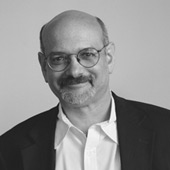 Steven Heller is the co-chair (with Lita Talarico) of the School of Visual Arts MFA Design / Designer as Author + Entrepreneur program and the SVA Masters Workshop in Rome. He writes the Visuals column for the New York Times Book Review,
Steven Heller is the co-chair (with Lita Talarico) of the School of Visual Arts MFA Design / Designer as Author + Entrepreneur program and the SVA Masters Workshop in Rome. He writes the Visuals column for the New York Times Book Review, 
